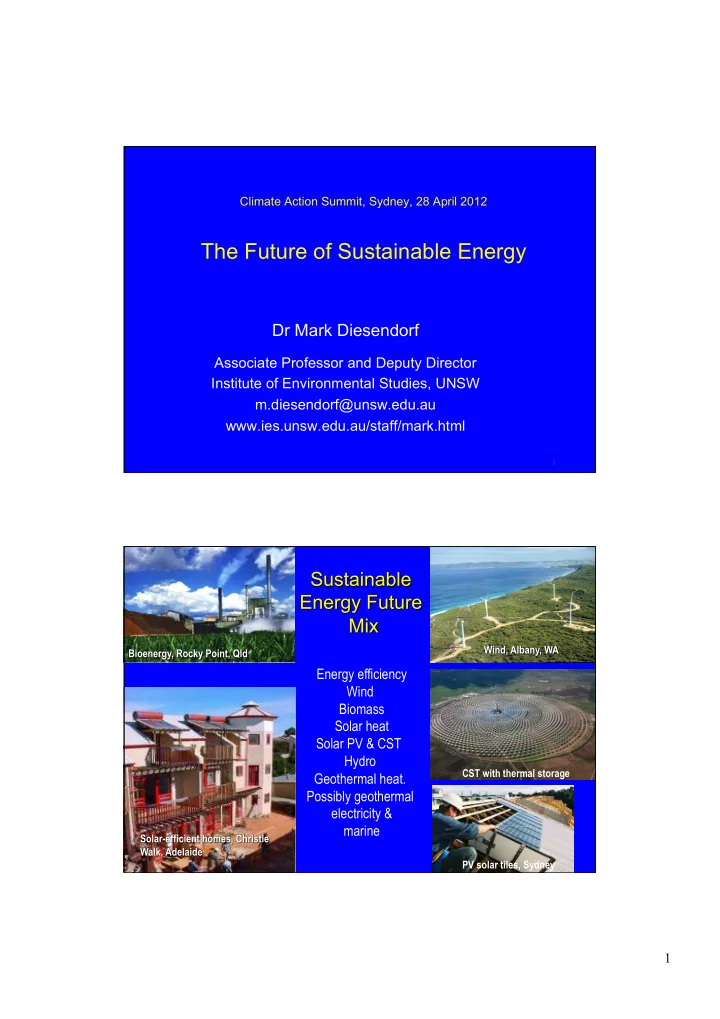

Climate Action Summit, Sydney, 28 April 2012 The Future of Sustainable Energy Dr Mark Diesendorf Associate Professor and Deputy Director Institute of Environmental Studies, UNSW m.diesendorf@unsw.edu.au www.ies.unsw.edu.au/staff/mark.html 1 Energy efficiency Wind Biomass Solar heat Solar PV & CST Hydro CST with thermal storage Geothermal heat. Possibly geothermal electricity & marine PV solar tiles, Sydney 2 1
Sustainable Energy = Energy Efficiency + Renewable Energy 3 3 How can Renewable Energy replace Fossil Fuels? Energy end-use Comment; Current fossil source Renewable energy substitute Electricity 35% of Australia’s GHG emissions. Could be supplied entirely by renewables within a few decades. mostly coal 14% of Australia’s GHG emissions. Transport mostly oil Electric vehicles for urban transport; inter-city high-speed rail; biofuels for rural vehicles & some air travel. About 17% of Australia’s GHG emissions Heat (non-electrical) mostly gas Low temperature heat from solar; some high temperature heat from renewable electricity; possibly biofuels. 2
UNSW Simulations of 100% Renewable Electricity (Elliston, Diesendorf & MacGill 2011; 2012) BZE’s Assumptions Removed in UNSW Study while maintaining reliability Discarded BZE’s expensive hypothetical transmission connection to WA Reduced CST’s annual share in electricity generation from BZE’s 60% to UNSW’s 30-40% of total annual generation Removed BZE’s back-up from transporting biomass to the outback to heat thermal storages in winter Replaced BZE’s daily solar energy data by hourly data UNSW economic assessment in progress 6 3
A UNSW Simulation of 100% Renewable Electricity A Typical Week in Summer 2010 (Elliston, Diesendorf & MacGill 2012 ) A UNSW Simulation of 100% Renewable Electricity A Challenging Week in Winter 2010 (Elliston, Diesendorf & MacGill 2011; 2012) 4
UNSW Simulations of 100% Renewable Electricity: Broad Results Same reliability obtained as existing NEM supply system: 0.002% energy shortfall. No supply system is 100% reliable. Principal challenge is supplying demand on several winter evenings following overcast days when winds are sometimes low. Handled in baseline scenario with high gas turbine capacity Gas turbines are commercial technology that can burn liquid or gaseous fuels, either fossil or renewable from biomass; eg Qantas flight Base-load power plant an unnecessary and outdated concept. Important thing is to have sufficient flexible plant to balance fluctuations in wind & PV. 9 Options for Reducing Gas Turbine Capacity while Maintaining Reliability – Sensitivity Analysis 10 5
Meeting Demand with & without Base-Load Stations Old concept Source of diagrams: David Mills New concept: No baseload or biofuelled gas turbine or hydro power stations In Transition towards 100% RE: Daily Demand & Supply with Partially Renewable Electricity Power CST+storage; hydro; gas turbines (gas & biofuels) Original base-load Wind + PV (increasing) coal Coal (decreasing to zero) Time of day 12 6
Recommended Additional Sustainable Energy Policies Increase Renewable Energy Target from 20% to 40% of electricity in 2020 and 60-80% in 2030 Set targets for energy efficiency and renewable heat, as in Europe Set feed-in tariffs to drive large-scale solar as well as small-scale Build transmission highways/spines Bring forward funding from Clean Energy Finance Corporation Remove subsidies to production & use of fossil fuels Support community renewable energy projects Pass energy efficiency regulations and standards for ALL occupied buildings & all energy-using appliances and equipment Implement really smart meters together with sophisticated demand management Broader Issues of Sustainable Development 14 7
Premature & Fallacious Critiques of 100% Renewable Energy (RE) on Economic Grounds (eg, Barry Brook; Peter Lang; Ted Trainer) 15 8
Recommend
More recommend